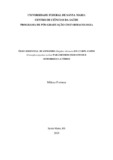| dc.creator | Fortuna, Milena | |
| dc.date.accessioned | 2021-06-10T17:55:39Z | |
| dc.date.available | 2021-06-10T17:55:39Z | |
| dc.date.issued | 2019-02-19 | |
| dc.identifier.uri | http://repositorio.ufsm.br/handle/1/21104 | |
| dc.description.abstract | Ginger (Zingiber oficinale) has several beneficial effects already investigated, in species
like Wistar rats and fish (Cyprinus carpio). In the organism, the harmful effect of free
radicals (ROS) occurs when they are in excessive amounts and the antioxidants combat
this effect. The Grass carp (Ctenopharyngodon idella), is the one of the most important
and most highly consumed freshwater fish species in the world. The aim of the present
study was to investigate the effects of ginger essential oil (EOG) as an antioxidant,
considering the physiology of grass carp. For this, the parameters evaluated were
biochemical, blood, ion flow and acetylcholinesterase (AChE). Data are reported as
mean ± SE. No mortality was registered for the duration of the experiments. Plasma
glucose and protein levels did not differ significantly among the groups, as
acetylcholinesterase in brain and muscle. On the three sampling times and two
concentrations EOG tested, SOD activity was significantly higher in the liver (17.36 ±
3.14, 17.19 ± 3.67) and in the kidney (15.97 ± 2.42, 16.48 ± 2.95), when compared to
the control group (14.63 ± 0.92, 14.09 ± 0.65), except for SOD activity in the liver after
1 hour (11.41 ± 3.42, 11.55 ± 1.58). GPx levels began to increase in the liver at 50 μL
L-1 from 4 hours of treatment (23.38 ± 0.65) to 8 hours (24.63 ± 4.82) at the
concentration of 100 μL L-1
, after 8 hours of exposure in the kidney (39.74 ± 7.62). The
concentration of 100 μL L−1
induced the stage of light sedation, after 1 hour which
lasted up to 8 hours. The ion flux of potassium (K+
) had an influx on the concentration
of 100 μL L−
as the ion chloride (Cl
-
) at 50 μL L-1
. The EOG induces the enzyme
antioxidant activity at both concentrations, improving oxidative levels, and has a light
sedation after 8 hours of expositon. | eng |
| dc.language | por | por |
| dc.publisher | Universidade Federal de Santa Maria | por |
| dc.rights | Attribution-NonCommercial-NoDerivatives 4.0 International | * |
| dc.rights.uri | http://creativecommons.org/licenses/by-nc-nd/4.0/ | * |
| dc.subject | Peixe | por |
| dc.subject | Gengibre | por |
| dc.subject | Estresse oxidativo | por |
| dc.subject | Produto natural | por |
| dc.subject | Fish | eng |
| dc.subject | Ginger | fra |
| dc.subject | Oxidative stress | eng |
| dc.subject | Natural product | eng |
| dc.title | Efeitos antioxidantes do óleo essencial de Zingiber oficinale em carpa capim (Ctenopharyngodon idella) | por |
| dc.title.alternative | Antioxidant effects of Zingiber oficinale essential oil in grass carp (Ctenopharyngodon idella) | eng |
| dc.type | Dissertação | por |
| dc.description.resumo | O gengibre (Zingiber oficinale) tem vários efeitos benéficos já investigados, em
espécies como ratos Wistar e peixes (Cyprinus carpio). No organismo, o efeito
prejudicial dos radicais livres (ROS) ocorre quando eles estão em quantidades
excessivas no corpo e os antioxidantes combatem esse efeito. A carpa capim
(Ctenopharyngodon idella) é uma das mais importantes e mais consumidas espécies de
peixes de água doce do mundo. O objetivo do presente estudo foi investigar os efeitos
do óleo essencial de gengibre (EOG) como antioxidante, considerando a fisiologia da
carpa capim. Para isso, os parâmetros avaliados foram bioquímicos, sanguíneos, de
fluxo iônico e acetilcolinesterase (AChE). Os dados são relatados como média ± desvio
padrão. Nenhuma mortalidade foi registrada durante os experimentos. Os níveis
plasmáticos de glicose e proteína total não diferiram significativamente entre os grupos,
assim como acetilcolinesterase no cérebro e músculo. Nos três tempos de amostragem e
duas concentrações testadas pelo EOG, a atividade da SOD foi significativamente maior
no fígado (17,36 ± 3,14, 17,19 ± 3,67) e no rim (15,97 ± 2,42, 16,48 ± 2,95), quando
comparada ao grupo controle (14,63 ± 0,92, 14,09 ± 0,65), exceto para a atividade da
SOD no fígado após 1 hora (11,41 ± 3,42, 11,55 ± 1,58). Os níveis de GPx começaram
a aumentar no fígado a 50 μL L-1
, de 4 horas de tratamento (23,38 ± 0,65) para 8 horas
(24,63 ± 4,82) na concentração de 100 μL L-1, após 8 horas de exposição no rim (39,74
± 7,62). A concentração de 100 μL L
− 1
induziu uma sedação leve. O fluxo iônico de
potássio (K +) teve um influxo na concentração de 100 μL L-1
como o íon cloro (Cl
-
) a
50 μL L-1
. O EOG induz a atividade antioxidante das enzimas em ambas as
concentrações, melhorando os níveis oxidativos, e tem um efeito leve de sedação após 8
horas de exposição. | por |
| dc.contributor.advisor1 | Cunha, Mauro Alves da | |
| dc.contributor.advisor1Lattes | http://lattes.cnpq.br/9745413680917763 | por |
| dc.contributor.referee1 | Baldisserotto, Bernardo | |
| dc.contributor.referee1Lattes | XXXXXXXXXXXXXXX | por |
| dc.contributor.referee2 | Gomes, Levy de Carvalho | |
| dc.contributor.referee2Lattes | XXXXXXXXXXXXXXXXXX | por |
| dc.creator.Lattes | XXXXXXXXXXXXXXXX | por |
| dc.publisher.country | Brasil | por |
| dc.publisher.department | Farmacologia | por |
| dc.publisher.initials | UFSM | por |
| dc.publisher.program | Programa de Pós-Graduação em Farmacologia | por |
| dc.subject.cnpq | CNPQ::CIENCIAS DA SAUDE::FARMACIA | por |
| dc.publisher.unidade | Centro de Ciências da Saúde | por |



